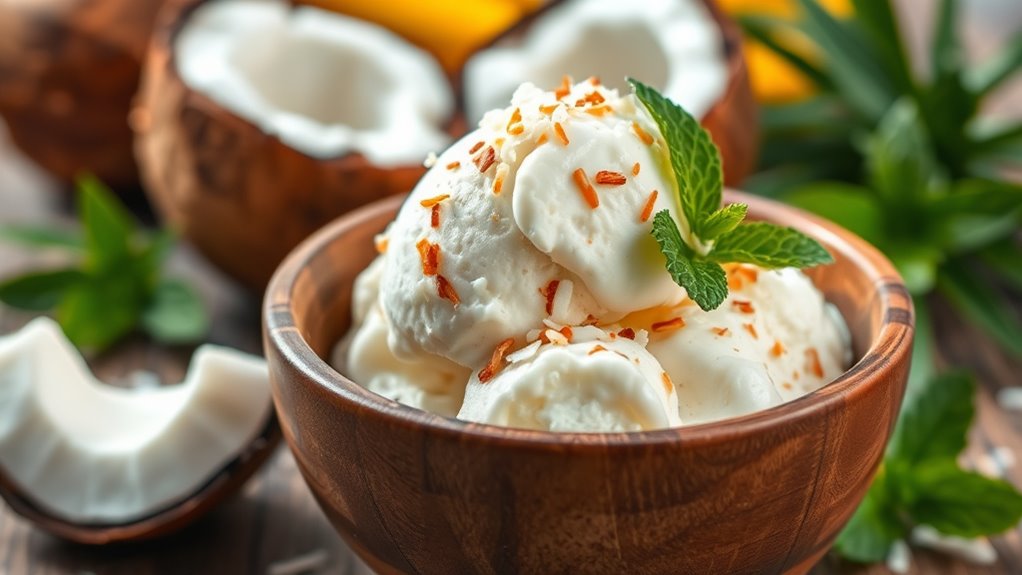To create creamy coconut milk ice cream, start with full-fat coconut milk and coconut cream for rich flavor. Use high-quality sweeteners and natural thickeners to avoid icy textures. A high-speed blender and ice cream maker will help achieve that smooth consistency. Keep an eye on churning time to avoid oiliness. Experiment with flavor variations and add-ins like vanilla or fruit. You’ll discover more yummy tips and tricks to perfect your ice cream-making skills along the way.
Key Takeaways
- Use full-fat coconut milk or coconut cream as the base for a rich and creamy texture.
- Incorporate natural sweeteners like coconut sugar or maple syrup to enhance flavor.
- Blend ingredients thoroughly in a high-speed blender for a smooth consistency.
- Utilize an ice cream maker for optimal creaminess, or try a no-churn method for convenience.
- Add natural stabilizers like glucomannan to improve texture and prevent ice crystals.
Essential Ingredients for Creamy Coconut Milk Ice Cream

To create a luscious coconut milk ice cream, you’ll need a few essential ingredients that work together to deliver that creamy texture and rich flavor.
Start with full-fat coconut milk as your base, providing a light, creamy foundation. Add coconut cream to enhance richness and achieve a velvety texture.
Begin with full-fat coconut milk for a creamy foundation, then enrich it with coconut cream for a velvety finish.
Sweeten with granulated sugar or alternatives like coconut sugar or maple syrup to balance the flavors. A splash of vanilla extract or paste adds warmth that complements the coconut beautifully. Additionally, this ice cream is dairy-free and vegan, making it a guilt-free treat for everyone.
For smoothness, consider thickeners like gelatin or cornstarch, and emulsifiers like lecithin.
These ingredients guarantee your ice cream isn’t just rich in flavor but also has the perfect consistency for a delightful treat.
Types of Coconut Products Used

Coconut products play an essential role in crafting delicious dairy-free ice cream. Full-fat coconut milk is your best bet, thanks to its high fat content, which delivers that creamy texture you’re after. Avoid lite coconut milk; its lower fat can lead to an icy outcome. Carton coconut milk might seem convenient, but it often has more water, impacting creaminess. For an even richer base, consider coconut cream, which has a higher fat content than full-fat coconut milk. Brands like Aroy-D and Savoy offer quality options without added gums. Remember to refrigerate your coconut products overnight to enhance cream separation, ensuring a smooth and delightful ice cream experience. Proper storage keeps these ingredients fresh longer, enhancing your final treat. Additionally, the use of high-quality coconut cream can significantly elevate the flavor profile of your ice cream.
Key Equipment for Making Coconut Ice Cream

When you’re ready to whip up your dairy-free coconut ice cream, having the right equipment makes all the difference.
Start with a high-speed blender for blending ingredients smoothly, or an ice cream maker to churn your mixture into creamy perfection. You’ll also need mixing bowls for combining ingredients, and loaf pans for freezing your ice cream once it’s churned. A refrigerator and freezer are essential for chilling and solidifying the mixture. Additionally, using full-fat canned coconut milk ensures a rich and creamy texture in your homemade ice cream.
If you’re making it without an ice cream maker, ice cube trays can be handy.
Don’t forget measuring cups and spoons for accuracy, and a spatula to scrape down the sides of your bowls. With these essentials, you’ll be well on your way to creating delicious coconut ice cream at home!
Techniques for Achieving Creamy Texture

Achieving a creamy texture in your dairy-free coconut ice cream hinges on a few key techniques. Start with high-fat coconut milk, as it creates that rich, creamy base. Consider adding thickeners like xanthan gum to prevent ice crystals from forming. Don’t forget about sweeteners such as organic cane sugar or maple syrup; they not only enhance flavor but also improve texture. A lightened-up version of this ice cream can be made by adjusting the sugar and fat content without compromising on deliciousness. Proper blending and churning are essential for a smooth consistency, so spend time on this step. Finally, guarantee you chill and freeze your mixture at the right temperatures to develop the perfect texture. Following these techniques will help you enjoy a delightful, creamy coconut ice cream every time!
Common Issues and Solutions

While making dairy-free coconut milk ice cream can be a delightful endeavor, several common issues might arise during the process. You might encounter an icy texture due to the high water content in coconut milk. To combat this, use full-fat coconut milk and consider adding stabilizers like gelatin or emulsifiers. Effective stabilizers can aid in preventing crystallization and improving texture. Additionally, incorporating butter’s emulsifying properties can enhance the creaminess and mouthfeel of your ice cream.
If your ice cream lacks creaminess, heating the base and blending it can help improve the texture. Graininess can be reduced by ensuring fat is evenly distributed during churning. Excessive coconut flavor can be balanced with vanilla or other flavorings.
Finally, to avoid hard ice cream, let it temper before serving, and consider using freezer-safe containers to maintain the ideal texture.
Flavor Variations and Add-Ins

Exploring flavor variations and add-ins can elevate your dairy-free coconut milk ice cream from ordinary to extraordinary.
Try tropical twists like Coconut Mango or Pineapple Coconut for a revitalizing taste. For fruit infusions, mix in fresh strawberries or raspberries for a fruity kick. Using coconut cream as a base provides a rich, creamy texture that enhances every flavor.
If you’re craving something nutty, consider blending in peanut butter or toasted almonds. Chocolate lovers can enjoy Chocolate Coconut or Nutella variations, while coffee enthusiasts might prefer a mocha coffee ice cream.
Don’t forget add-ins like crunchy toasted coconut flakes, chocolate chips, or cookie dough chunks. Swirl in salted caramel or fruit sauces for extra decadence.
With these flavors and mix-ins, you’ll create a delightful treat that’s truly your own!
Step-by-Step Recipe for Coconut Milk Ice Cream

To create your own delicious coconut milk ice cream, you’ll need a few key ingredients and some simple equipment. Start with full-fat coconut milk, sugar (like granulated or maple syrup), and optional thickeners like cornstarch. This recipe is perfect for summer treats and family activities, as it is made with 5 simple ingredients. A high-speed blender will help you blend these until smooth. If desired, heat the mixture to dissolve the sugar before refrigerating it to cool.
Create your own delicious coconut milk ice cream using full-fat coconut milk, sugar, and optional thickeners for a creamy treat!
Once chilled, churn the mixture in an ice cream maker for a creamy texture. After churning, freeze it for a few hours in an airtight container.
For serving, let it thaw slightly for easier scooping. Enjoy your homemade coconut milk ice cream with your favorite mix-ins for a delightful treat!
Tips for Perfecting Your Ice Cream Making Skills

Mastering the art of ice cream making can elevate your homemade treats to a whole new level. Start by chilling your base thoroughly; this helps form smaller ice crystals for that creamy texture you crave. Use full-fat coconut milk to enhance richness and prevent iciness. Chilling ensures fast churning into ice cream and improves flavor and texture, making it a crucial step in the process. Incorporating whole foods into your recipes can also enhance the nutritional value of your ice cream.
An ice cream maker is ideal for smooth results, but if you don’t have one, a no-churn method works too. Choose high-quality, cold ingredients for the best flavor and texture. Pay attention to your churning time—over-churning can lead to an oily mouthfeel.
Finally, consider using natural stabilizers like glucomannan to improve texture and maintain creaminess. With these tips, you’ll be well on your way to ice cream perfection!
Frequently Asked Questions
Can I Use Low-Fat Coconut Milk for Ice Cream?
You can use low-fat coconut milk for ice cream, but it won’t give you the creamy texture you’re likely aiming for.
Low-fat options often result in a more icy consistency, which isn’t ideal. If you want a creamier ice cream, consider using full-fat coconut milk or a mix of coconut milk and coconut cream.
This combination will help achieve that rich, smooth texture you desire, making your ice cream more enjoyable.
How Long Does Homemade Coconut Ice Cream Last?
Imagine diving into a bowl of your homemade coconut ice cream, only to find it’s lost its magic.
Once opened, your coconut ice cream typically lasts about six weeks in the freezer, but for the best experience, try to enjoy it within two weeks.
Keep it tightly sealed and stored in the coldest part of the freezer to preserve that delightful creaminess.
Treat it well, and it’ll reward you with each scoop!
Is Coconut Ice Cream Suitable for Vegans?
Yes, coconut ice cream is perfect for you as a vegan!
It’s made from plant-based ingredients like coconut milk and cream, which provide a rich and creamy texture without any animal products. You can customize it with natural sweeteners and flavors to suit your taste.
Plus, it’s a great alternative if you’re avoiding dairy due to lactose intolerance or allergies.
Enjoy indulging in a delicious dessert that aligns with your dietary choices!
Can I Make Coconut Ice Cream Without an Ice Cream Maker?
You might find it surprising that making coconut ice cream without an ice cream maker isn’t only possible but also easy.
Just blend your ingredients until smooth, pour the mixture into a container, and freeze it. Stir occasionally to achieve that creamy texture.
If you’re feeling adventurous, use a high-powered blender to churn it after freezing. You’ll enjoy a delicious treat tailored to your taste, all without fancy equipment!
What’S the Best Way to Store Leftover Coconut Ice Cream?
To store leftover coconut ice cream, place it in an airtight container to prevent freezer burn.
Make sure the container’s lid is secure and store it in the freezer, where it’ll last for about two months.
When you’re ready to enjoy it, take it out 15 minutes before serving to let it soften.
This way, you’ll get the best texture and flavor from your delicious treat!
Conclusion
Ultimately, making creamy coconut milk ice cream is like crafting a delicious dream that dances on your taste buds. With the right ingredients and techniques, you can create a delightful treat that’s as satisfying as a warm summer day. Don’t shy away from experimenting with flavors or add-ins; each batch is an opportunity for a new adventure. So grab your equipment, follow the steps, and let your ice cream journey begin! Enjoy every scoop!










